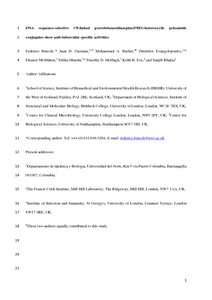Brucoli, F; Guzman, JD; Basher, MA; Evangelopoulos, D; McMahon, E; Munshi, T; McHugh, TD; Fox, KR; Bhakta, S
(2016)
DNA sequence-selective C8-linked pyrrolobenzodiazepine-heterocyclic polyamide conjugates show anti-tubercular-specific activities.
J Antibiot (Tokyo), 69 (12).
pp. 843-849.
ISSN 0021-8820
https://doi.org/10.1038/ja.2016.43
SGUL Authors: Munshi, Tulika Kishanlal
![[img]](https://openaccess.sgul.ac.uk/109673/1.hassmallThumbnailVersion/Anti-tubercular%2520activities%2520of%2520PBD%2520conjugates_SB%2520final.pdf)  Preview |
|
PDF
Accepted Version
Available under License ["licenses_description_publisher" not defined].
Download (567kB)
| Preview
|
Abstract
New chemotherapeutic agents with novel mechanisms of action are in urgent need to combat the tuberculosis pandemic. A library of 12 C8-linked pyrrolo[2,1-c][1,4]benzodiazepine (PBD)-heterocyclic polyamide conjugates (1-12) was evaluated for anti-tubercular activity and DNA sequence selectivity. The PBD conjugates were screened against slow-growing Mycobacterium bovis Bacillus Calmette-Guérin and M. tuberculosis H37Rv, and fast-growing Escherichia coli, Pseudomonas putida and Rhodococcus sp. RHA1 bacteria. DNase I footprinting and DNA thermal denaturation experiments were used to determine the molecules' DNA recognition properties. The PBD conjugates were highly selective for the mycobacterial strains and exhibited significant growth inhibitory activity against the pathogenic M. tuberculosis H37Rv, with compound 4 showing MIC values (MIC=0.08 mg l-1) similar to those of rifampin and isoniazid. DNase I footprinting results showed that the PBD conjugates with three heterocyclic moieties had enhanced sequence selectivity and produced larger footprints, with distinct cleavage patterns compared with the two-heterocyclic chain PBD conjugates. DNA melting experiments indicated a covalent binding of the PBD conjugates to two AT-rich DNA-duplexes containing either a central GGATCC or GTATAC sequence, and showed that the polyamide chains affect the interactions of the molecules with DNA. The PBD-C8 conjugates tested in this study have a remarkable anti-mycobacterial activity and can be further developed as DNA-targeted anti-tubercular drugs.
| Item Type: |
Article
|
| Additional Information: |
This is a post-peer-review, pre-copyedit version of an article published in Journal of Antibiotics. The final authenticated version is available online at: http://dx.doi.org/10.1038/ja.2016.43 |
| Keywords: |
Animals, Antitubercular Agents, Base Sequence, Benzodiazepines, DNA Footprinting, DNA, Bacterial, Deoxyribonuclease I, Escherichia coli, Isoniazid, Mice, Microbial Sensitivity Tests, Mycobacterium bovis, Mycobacterium tuberculosis, Nylons, Pseudomonas putida, Pyrroles, RAW 264.7 Cells, Rhodococcus, Rifampin, Sequence Analysis, DNA, Medicinal & Biomolecular Chemistry, 0605 Microbiology, 1115 Pharmacology And Pharmaceutical Sciences |
| SGUL Research Institute / Research Centre: |
Academic Structure > Infection and Immunity Research Institute (INII) |
| Journal or Publication Title: |
J Antibiot (Tokyo) |
| ISSN: |
0021-8820 |
| Language: |
eng |
| Dates: |
| Date | Event |
|---|
| December 2016 | Published | | 11 May 2016 | Published Online | | 14 March 2016 | Accepted |
|
| Publisher License: |
Publisher's own licence |
| Projects: |
| Project ID | Funder | Funder ID |
|---|
| G0801956 | Medical Research Council | UNSPECIFIED | | G0802079 | Medical Research Council | UNSPECIFIED |
|
| PubMed ID: |
27168314 |
 |
Go to PubMed abstract |
| URI: |
https://openaccess.sgul.ac.uk/id/eprint/109673 |
| Publisher's version: |
https://doi.org/10.1038/ja.2016.43 |
Statistics
Item downloaded times since 21 Mar 2018.
Actions (login required)
 |
Edit Item |



